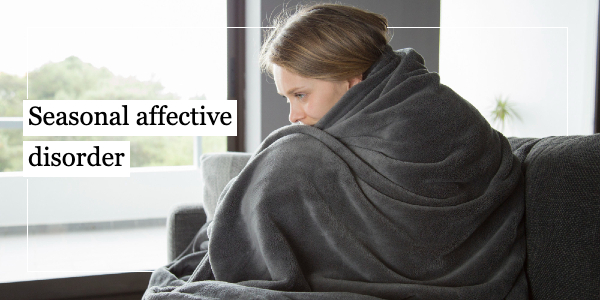Seasonal Affective Disorder: What It Is and How to Cope
- SAD is a type of depression triggered by seasonal changes, most often in fall and winter.
- Causes include reduced sunlight, changes in brain chemicals, and disrupted sleep patterns.
- Symptoms vary by season but often include low mood, sleep changes, appetite shifts, and low energy.
- Effective treatments include light therapy, vitamin D, CBT, medication, and healthy lifestyle habits.
- Early recognition and professional support can help manage and reduce SAD symptoms.

Seasonal Affective Disorder (SAD), often referred to as seasonal depression, is recognized as a type of major depressive disorder. This condition is characterized by its unique timing, typically occurring at specific times of the year. Unlike general depression, which is a persistent state of low mood that significantly hinders daily functioning, SAD is closely linked to seasonal changes.
Individuals experiencing SAD typically report feelings of depression that are triggered by specific seasons or weather conditions. The most common onset of SAD symptoms is in the late fall, continuing through the winter months. Mood swings and a noticeable drop in energy levels mark this period. While the symptoms generally begin in the fall and continue into winter, they tend to subside with the arrival of spring and summer. However, it’s important to note that in rarer cases, SAD can manifest during the spring or early summer, though it typically resolves in the fall or winter.
Causes of Seasonal Affective Disorder (SAD)
Seasonal Affective Disorder (SAD), commonly referred to as winter depression or the winter blues, is a type of depression that typically emerges during specific times of the year, particularly in fall and winter when daylight is scarce. Interestingly, a less intense form of SAD can occur during spring and summer, though this is less common.
Understanding the Causes of SAD
Shift in Biological Clock: The reduced sunlight in fall and winter may cause a shift in your internal biological clock, or circadian rhythm, which regulates mood, sleep, and hormones. This shift can disrupt your daily routine and make it challenging to adjust to changes such as daylight saving time.
Chemical Imbalance in the Brain: SAD may be linked to a reduction in serotonin, a neurotransmitter that aids in nerve communication and promotes a sense of well-being. Sunlight typically helps maintain serotonin levels, so the reduced sunlight in winter can lead to a decrease in serotonin, contributing to depressive symptoms.
Additionally, vitamin D plays a role in serotonin activity. Since sunlight is a key source of vitamin D, the lack of sun exposure in winter can result in lower vitamin D levels, further influencing mood and serotonin levels.
Increase in Melatonin Production: Melatonin, a hormone that regulates sleep patterns and mood, can be produced at higher levels during periods of limited sunlight. Excess melatonin can lead to feelings of sluggishness and sleepiness, common symptoms in people with SAD.
Negative Thought Patterns: The stress, worry, and negative thoughts that often accompany winter can exacerbate or possibly trigger SAD symptoms. However, it remains unclear whether these thoughts are a cause or a result of the disorder.
Different Patterns of Seasonal Affective Disorder (SAD)
Seasonal Affective Disorder (SAD) manifests in distinct patterns, primarily influenced by seasonal changes. While many people experience a mild form of mood changes known as the “winter blues” during the shorter, darker days of fall and winter, others may face more significant mental health challenges. When these seasonal mood fluctuations significantly impact one’s thoughts, feelings, and behaviors, it may indicate the presence of SAD.
Winter-Pattern SAD or Winter Depression
This is the most common form of Seasonal Affective Disorder. Individuals with winter-pattern SAD typically begin experiencing symptoms in late fall or early winter, which tend to alleviate in the spring and summer. The symptoms are often related to the reduced level of sunlight during the winter months and can significantly affect mood and energy levels.
Summer-Pattern SAD or Summer Depression
Contrary to the more prevalent winter pattern, some individuals experience SAD during the warmer months of spring and summer. Known as summer-pattern SAD or summer depression, these individuals face depressive symptoms during the longer, sunnier days. This form of SAD is less common, and its symptoms can be quite different from those experienced in the winter pattern.
Symptoms of Seasonal Affective Disorder (SAD)
Seasonal Affective Disorder (SAD) presents a range of symptoms that can vary in intensity and impact. Recognizing these signs is crucial for understanding and addressing this disorder effectively. The symptoms of SAD can be divided into those more commonly associated with winter-pattern SAD and those often observed in summer-pattern SAD.
Winter-Pattern SAD Symptoms
- Feeling depressed, hopeless, or worthless almost every day.
- A noticeable drop in energy levels or constant fatigue.
- Oversleeping or difficulty sleeping.
- A strong desire for carbohydrate-rich foods.
- Tendencies to eat more and subsequent weight gain.
- Challenges in focusing on tasks.
- Persistent negative thoughts about oneself.
Summer-Pattern SAD Symptoms
- Feelings of sadness or emptiness that persist most of the time.
- Difficulty in falling or staying asleep.
- A noticeable decrease in appetite leads to weight loss.
- Increased levels of nervousness or restlessness.
- Becoming easily frustrated or annoyed.
- Severe despair or suicidal thoughts.
It’s important to note that while these symptoms can significantly affect one’s daily life, they are not permanent and tend to align with seasonal changes. Understanding these symptoms is the first step in seeking appropriate treatment and support for Seasonal Affective Disorder.
Treating Seasonal Affective Disorder (SAD)
Seasonal Affective Disorder (SAD), whether in its winter or summer forms, can be addressed through a variety of treatments. These methods can be used individually or in combination, depending on the severity of the condition and the individual’s response to different therapies.
Light Therapy (Phototherapy)
This is a primary treatment for winter-pattern SAD. Light therapy involves daily exposure to a bright light that mimics natural sunlight. It’s effective in regulating circadian rhythms and neurotransmitter production, which is crucial in alleviating symptoms of SAD. Sessions usually last around 20-30 minutes and are proven to improve mood and sleep patterns.
Vitamin D Supplements and Sun Exposure
For those lacking sufficient vitamin D, which is common in winter-pattern SAD, supplements or increased sun exposure may help. While studies on vitamin D as a treatment for SAD have shown mixed results, some evidence suggests it can be as effective as light therapy in certain cases.
Cognitive-Behavioral Therapy (CBT)
CBT is a form of psychotherapy that helps in modifying negative thoughts and behaviors associated with SAD. It’s effective in building coping strategies and improving interpersonal relationships. CBT can help individuals understand and manage the stressors that exacerbate their condition.
Antidepressant Medication
For severe cases of SAD, especially when accompanied by significant depression, antidepressants can be prescribed. These medications aim to correct the chemical imbalances in the brain that contribute to depressive symptoms. It’s important to consult a healthcare provider for proper diagnosis and prescription.
Setting Attainable Goals
Managing SAD involves setting realistic goals and breaking down tasks into smaller, manageable steps. This approach helps in reducing the overwhelming feeling that can accompany depression.
Social Support
Engaging in social activities and maintaining open communication with friends, family, or support groups can provide emotional support and reduce feelings of isolation often associated with SAD.
Engaging in Relaxing Activities
Participating in activities that bring joy and relaxation, such as watching movies, gardening, or attending social events, can help improve mood and provide a sense of well-being.
Adopting a Healthy Lifestyle
Regular physical activity, a balanced diet, and avoiding substances like alcohol and drugs that can worsen symptoms are crucial for managing SAD.
Each of these treatment options offers a way to manage and alleviate the symptoms of Seasonal Affective Disorder, and often, a combination of these methods yields the best results. Individuals must work with healthcare professionals to find the most effective treatment plan for their needs.
Conclusion
If you suspect that you or someone you know may be experiencing Seasonal Affective Disorder (SAD), or if you recognize symptoms of depression that align with certain seasons, it’s essential to seek professional medical advice. Consulting with a healthcare professional is a critical step in receiving a comprehensive evaluation of your symptoms and condition. This evaluation is key to determining the most effective treatment approach, which may include a combination of therapies tailored to your specific needs.
Authored By

Shebna N Osanmoh is a board-certified Psychiatric Mental Health Nurse Practitioner with extensive experience across the mental health spectrum. Holding a Master’s in Psychiatric/Mental Health Nursing from Walden University, Shebna provides compassionate, culturally sensitive care for a wide range of mental health conditions, emphasizing holistic and individualized treatment approaches to support patients in their wellness journey.